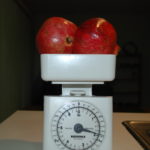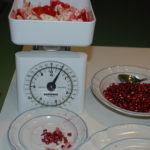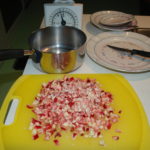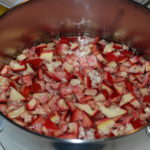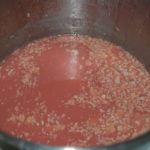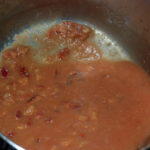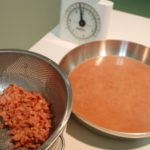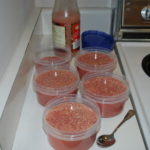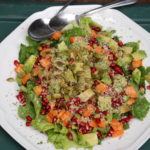For ease of use, a summary of the links and information available about health benefits of pomegranate seeds, juice and peel; serving size information that is based on animal based research studies and my own use of different pomegranate ingredients; and a concise recipe for the pomegranate peel extract recipe that I’ve developed.
Additional note: Pomegranate peel powder is available in a 10 ounce package. (Esutras Organics brand) The amount of the extract from my recipe (one tablespoon) that I use daily for anxiety/mood stability and to reduce finger numbness would be equivalent roughly to 375 milligrams of powdered pomegranate peel (375 mg ~ less than a 1/8th teaspoon, a small size capsule). The company ad suggests using it in soups or sauces, for optimal medicinal benefits I would suggest adding it only at the end of the cooking time. Overheating the extract seems to reduce some of the symptom relief that it provides for me.
Health benefits of pomegranate:
Pomegranate extract has been studied in animal based research to examine in more detail how it helps hypertensive blood pressure problems and reduce oxidative stress. The mechanism was found to involve increasing Nrf2. The formation of mitochondria increased, and their function improved. Before treatment the hypertensive animals had fewer of the specialized proteins that are involved in production of mitochondria. Mitochondria are the cellular organelles primarily responsible for turning blood sugar/glucose into usable energy. (5)
This study uses a pomegranate extract that incorporates the peel, seeds and juice as all contain the bioactive phytonutrient, punicalagin, thought to be most helpful for anti-inflammatory, anti-tumor and anti-diabetic effects. The animals who received the extract were found to have better blood pressure, reduced heart hypertrophy ( a sign of worse heart health) and a lower heart rate. Neuronal/nerve cell activity and oxidative stress markers were decreased in the experimental treatment group compared to the control group which received a saline solution and no pomegranate extract.
Angiotensin converting enzyme which is involved in blood pressure control was lower in the experimental group which received pomegranate extract and may be the mechanism for the lower blood pressure. Pro-inflammatory cytokines were reduced in the experimental group after treatment, an indication that hypertensive inflammation was reduced. The pomegranate extract treatment led to increased levels of phosphorylated AMPK which then leads to an increase in Nrf2 and its resulting increases in antioxidant proteins which protect against injury and inflammation from oxidative stress chemicals. (5)
I’ve since written a more comprehensive list of research on the health benefits and industrial uses of pomegranate peel extract and its chemical content, see this document, Medicinal Potential of Pomegranate Peel, and Recipes: docs.google.com/document/
Serving size that might be needed for general health or for special health needs:
Animal based research used a range of 1 – 10 grams/kilogram for 8 weeks was found to be beneficial for treatment of hepatocellular carcinoma (6); which for a human sized person might be equivalent to a a quarter to a half cup to a couple cups per day. (See this post for more details) The larger dose would likely be most beneficial used in smaller amounts throughout the day or in a couple portions. For example: Half a cup per day might be used for someone who is less ill and someone with more severe illness or genetic needs such as myself (I can’t make phospholipids and the pomegranate seeds and peel are a source) might use up to a half a cup every three to four hours throughout the hours spent awake – or whatever helped the symptoms. If every cell of the body needs the substances, every hour of the twenty-four, then one dose one time per day might leave the body under-treated for most of the 24 hours and only relieve symptoms for a few hours. The peel extract has a diuretic effect so using it earlier in the day and having a few extra glasses of water is mentioned in more detail later in this section.
I have found 1/3 to 1/2 cup of fresh seeds or pomegranate juice per day to help relieve my symptoms of anxiety and finger numbness (similar to Raynaud’s Disease but no diagnosis). Other patient forum feedback suggests one capsule of commercially available pomegranate juice concentrate was also helpful for Raynaud’s disease finger numbness or pain. (Avoiding letting the hands get too cold also can help prevent the condition from feeling as painful rather than just being a constant numbness in the fingertips.)
If I have pomegranate extract on hand I use a few tablespoons to about 1/3 cup per day and find it even more beneficial for relieving symptoms of anxiety or nerve numbness. However it has a diuretic effect so it is better to use it earlier in the day rather than at dinnertime and to have plenty of water or other water based beverages early in the day so sleep isn’t interrupted with a need to relieve the bladder. It is important to drink a little extra water or the urge to urinate can be painful and produce little flow. The body removes acidity by making a more concentrated urine – so add water yourself or a dilute juice or herbal tea and the kidneys will also be removing other toxins too which may increase health benefits.
Dried powdered pomegranate seeds are available at some India food grocery stores or websites look for a small box labeled Anardana. It seems to be a dried powder of the whole seeds and it is gritty and tart with a fruit flavor. I added a couple tablespoons to a batch of soup and that seemed to soften the gritty effect. It was good added after cooking, giving a nice tartness but there was a slight gritty texture occasionally, not too noticeable though. Anardana Powder, dried pomegranate seed powder – an example of the product available online:
- Yogijis.co.nz Phone: (03) 390 3434 Email: orders@yogijis.nz
- Anardana Powder, Powder of Dried Pomegranate Seeds: net Wt. 100 g//3.5 oz for $3.99
An organic pomegranate juice concentrate is also available in the same quantity for a larger price. That seems like a lot of money for a 3.5 oz package which is slightly less than a half cup amount, unless you were comparing it to prepared capsules of a pomegranate product which might cost 20 to 30 dollars for one bottle of capsules:
- Matakanasuperfoods.com, PO Box 18, Matakana 0948 New Zealand / Physical address: 108 Omaha Flats Rd. Auckland, New Zealand, Phone: 09 422 9618 Outside New Zealand: +64 9 422 9618
- Organic Pomegranate Juice Powder, 100g, $NZ 29,95
Sumac and Za’atar
A spice commonly used in Middle Eastern cooking and readily available at Middle Eastern grocery market may provide some similar health benefits to pomegranate. It is a dried powdered form of Sumac that has a lemony flavor. it is typically sprinkled on food individually at the table alone or in a mix with salt or with a few other spices and sesame seeds in a mixture called za’atar (link). I have found that using more than a half teaspoon can cause the diuretic effect similar to the pomegranate extract’s effects. Studies on health benefits of Sumac have found benefit for a number of inflammatory conditions so using some in small amounts daily may have preventative health benefits against oxidative stress.
Pomegranate Extract Recipe and Spicy variation:
Pomegranate Extract, basic recipe:
- Peel and inner membrane of two pomegranates
- Two to three cups of water, plus additional 2-3 cups for straining/rinsing step
- Two Tablespoons of Coconut oil
- Rinse the pomegranates before separating the seeds from the peel. Cutting the rind about a quarter inch deep in six sections can make it easier to open and remove the seeds. Save the juicy seeds for use fresh or place in a freezer container and store in the freezer for later use. Trim the peel to remove any spoiled or discolored spots on the outer peel or inner membranes. Discard. Rinse the remaining peel and chop into quarter to half inch sections.
- In a soup or stock pot place the chopped peel, water and coconut oil and bring to a gentle simmer and turn down the heat to continue at a gentle simmer. Try not to reach a vigorous boiling point. Simmer the mixture for 20-30 minutes while stirring occasionally to prevent the fibrous slightly sweet membrane particles from sticking to the pan.
- Remove from heat and strain the liquid into another large pan or bowl. The peel and membrane fiber is pulpy and can be rinsed with additional water to increase yield of the pulpy extract. Add one cup warm water and stir and strain the pulp and then add another one cup warm water, stir and strain, and maybe one or two more cups until the liquid seems more water like instead of a slightly thickened pale pinkish or creamy yellow color.
- Store the pomegranate extract in the refrigerator if it will be used in other recipes within a few days or freeze the excess in small containers for gradual use.
- It is very acidic and using a couple spoonfuls per day added to a soup or salad in place of lemon juice or vinegar can be a tasty way to use it. Diluting a few spoonfuls to 1/3 cup with an additional 2/3 cup of water or regular juice of some sort and adding a pinch of baking soda can make it tolerable as a beverage. One third cup per day should provide adequate health benefits for someone using it for that purpose.
Pomegranate Extract made with dehydrated pomegranate peel
Repeat the above steps using pomegranate peel and membrane that had been prepared and diced into 1/4-1/2 inch sections and dehydrated for long term storage – planning ahead for when pomegranates were no longer in season. One pomegranate peel/membrane produced approximately 30 grams of dried peel and which measured at slightly less than a 1/2 cup of dried pieces loosely packed. Per one pomegranate amount of peel simmer with one tablespoon of coconut oil and 2 cups of water, about 20-30 minutes on low heat. After straining the heated peel I rinsed the peel with two cups of water poured over it gradually while stirring. The yield was three cups of pomegranate extract.
Spicy Pomegranate Extract, Slightly less acidic and slightly thickened and emulsified Spicy:
- 6 cups of pomegranate extract (previous post) (in a more recent version I include 2 tablespoons of Rosemary and 2 tablespoons of Thyme during the simmering process, and strain out the herbs along with the simmered pomegranate peel. Both herbs have anti-inflammatory and other beneficial effects. They add a savory flavor to the mixture that is less noticeable once the Cardamom is added. I use a spoonful in my cup of coffee in the morning or in a bowl of soup. One or a few spoonfuls per day seems to help balance my mood (7, 8) and symptoms of numbness in my fingertips.)
- 2 Tablespoons Cardamom powdered spice
- 1 teaspoon Gumbo File powdered spice (Sassafras Leaves, powdered and used in Gumbo soups or stews in Creole style cooking)
- 1 teaspoon Baking Powder
- Add the Cardamom and Gumbo File to the Pomegranate Extract and stir well to break apart any dry lumps of the powdered spices. The Gumbo File acts as an emulsifier and is a digestive aid and the Cardamom adds flavor, phytonutrients and would help alkalize the mixture in addition to the alkalizing power of the Baking Soda.
- Bring the mixture to a boil.
- Add the Baking Soda and stir. Remove the mixture from the heat and keep stirring. It will froth up and stirring helps keep it from frothing over the top of the pan. The color changes from pinkish to brown from the Cardamom spice.
- To drink as a beverage dilute with equal parts water to Pomegranate Extract.
Disclaimer: Opinions are my own and the information is provided for educational purposes within the guidelines of fair use. While I am a Registered Dietitian this information is not intended to provide individual health guidance. Please see a health professional for individual health care purposes.
References:
- Claude Prigent, Editor, Protein Phosphorylation, Publisher: InTech, Chapters published November 29, 2017 under CC BY 3.0 licenseInTechOpen.com, https://www.intechopen.com/books/protein-phosphorylation (4)
- Wenyan Sun, Chunhong Yan, Bess Frost, Xin Wang, Chen Hou, Mengqi Zeng, Hongli Gao, Yuming Kang,and Jiankang Liu,
Pomegranate extract decreases oxidative stress and alleviates mitochondrial impairment by activating AMPK-Nrf2 in hypothalamic paraventricular nucleus of spontaneously hypertensive rats., Sci Rep. 2016; 6: 34246. https://www.ncbi.nlm.nih.gov/pmc/articles/PMC5054377/ (5)
- Anupam Bishayee, Deepak Bhatia, Roslin J. Thoppil, Altaf S. Darvesh, Eviatar Nevo, and Ephraim P. Lansky., Pomegranate-mediated chemoprevention of experimental hepatocarcinogenesis involves Nrf2-regulated antioxidant mechanisms., Carcinogenesis. 2011 Jun; 32(6): 888–896. https://www.ncbi.nlm.nih.gov/pmc/articles/PMC3314278/ (6)
- Muramatsu H, Katsuoka F, Toide K, Shimizu Y, Furusako S, Yamamoto M. Nrf2 deficiency leads to behavioral, neurochemical and transcriptional changes in mice, Gene Cells. 2013 Oct;18(10):899-908. https://onlinelibrary.wiley.com/doi/full/10.1111/gtc.12083 (7)
- Dopamine Imbalance and Its Effect on Compulsive Behaviors, http://sites.tufts.edu/emotiononthebrain/2014/10/10/dopamine-imbalance-and-its-effect-on-compulsive-behaviors/ (8)

